Until January 6, 2019, the Salotto del Cavalier Tempesta, a precious room entirely frescoed by Pieter Mulier known as Cavalier Tempesta (Haarlem, 1637 - Milan, 1701), can be visited in Genoa’s Palazzo Nicolosio Lomellino. These frescoes have recently been restored and returned to public enjoyment, and their opening is accompanied by an exhibition dedicated to Carlo Antonio Tavella (Milan, 1668 - Genoa, 1738), an important landscape painter who was in Mulier’s workshop for six years (for more information on the event you can read the article linked here). We talked about these frescoes, their importance and legacy with art historian Margherita Priarone (of the Musei di Strada Nuova in Genoa), who together with Raffaella Besta and Gianluca Zanelli curated the exhibition. And she also anticipated that we will soon see in Genoa an important exhibition of Dürer’s splendid prints, unique in the Italian panorama. The interview, the first in a series featuring young art historians, is curated by Federico Giannini, editor in chief of Finestre sull’Arte.
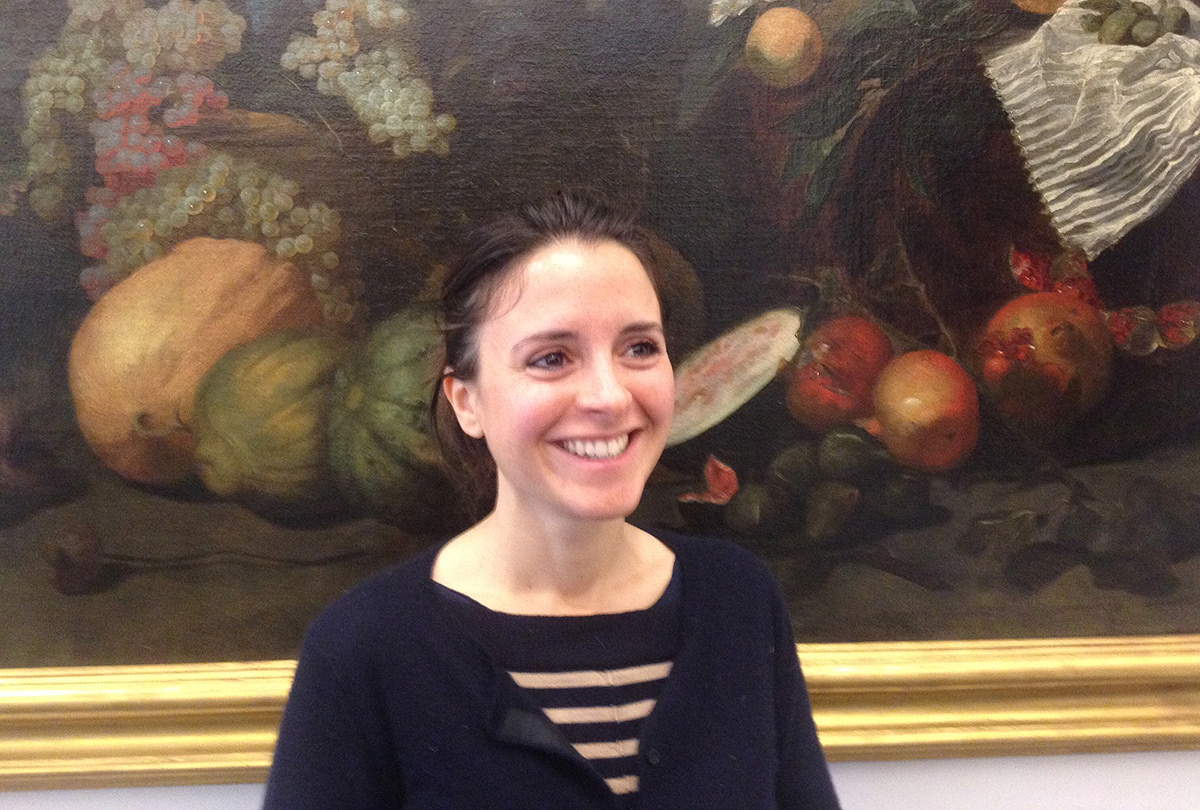 |
| Margherita Priarone |
FG. Dr. Priarone, let’s start with your latest project, the opening to the public of the Cavalier Tempesta Drawing Room at Palazzo Nicolosio Lomellino. For the first time the public has the opportunity to see the important frescoes that Pieter Mulier known as the Cavalier Tempesta created in this space: can you tell us about the frescoes and their importance?
MP. These frescoes were recovered with a restoration a few years ago but had never been enhanced with a dedicated project and opened to the public with also an exhibition next to it, enhancing their contents. They are frescoes that are made at the end of the seventeenth century, by this Dutch artist who had trained in Flanders, in Antwerp, and with a stay in Italy between various regions (Emilia, Rome, Lombardy) had refined the elaboration of a theme then very much in vogue, that of the landscape. A landscape that becomes an autonomous subject and also becomes the subject of frescoes, which is rather unusual, at least at that time in Genoa. So, for the first time, subjects that were normally reserved for picture-frame paintings are proposed on the walls, and it is interesting that these frescoes are conceived as frescoes in a frame, in the sense that the painter pretends pictures in a frame by frescoing them: it is therefore a pretence of a picture-frame fresco. They are beautiful subjects that then determine a trend of taste that from Cavalier Tempesta will spread, in Genoa, in the production of other artists: one among all is Carlo Antonio Tavella. And that is why in one of the rooms on the same floor there is an exhibition dedicated to Carlo Antonio Tavella with works from the Strada Nuova Museums.
And about the paintings of Carlo Antonio Tavella, a distinguished landscape painter active between the seventeenth and eighteenth centuries who was also in Mulier’s workshop: what was the training of this artist and what are his main works in Genoa?
Carlo Antonio Tavella was born in Milan but was of Genoese descent, and he also traveled around Italy (to Rome, to Emilia, to Tuscany), and so he came into contact, beyond his training in the Lombard area already as a landscape painter, with experiences of other landscape painters who were active in Tuscany and Rome, from Gaspard Dughet to Nicolas Poussin and Salvator Rosa, so he elaborated a series of suggestions that came from other artists and made them his own, and he popularized this landscape theme, in Genoa, really across the board: the landscape frescoes he painted in 1691-1692 at Palazzo Rosso, then not far from Cavalier Tempesta’s example at Palazzo Nicolosio Lomellino, are documented and dated. These frescoes can still be seen in the postwar setting, then framed by Franco Albini’s tapestries in Palazzo Rosso. And then he produced other fresco cycles, again with landscapes sometimes in false frames, like those of Cavalier Tempesta, and then paintings like those that the Strada Nuova Museums lent to Palazzo Nicolosio Lomellino. Finally, mention must be made of the drawings, which are very fascinating to the public because they return precisely the first design idea of an artist on paper, before transposition in large on canvas.
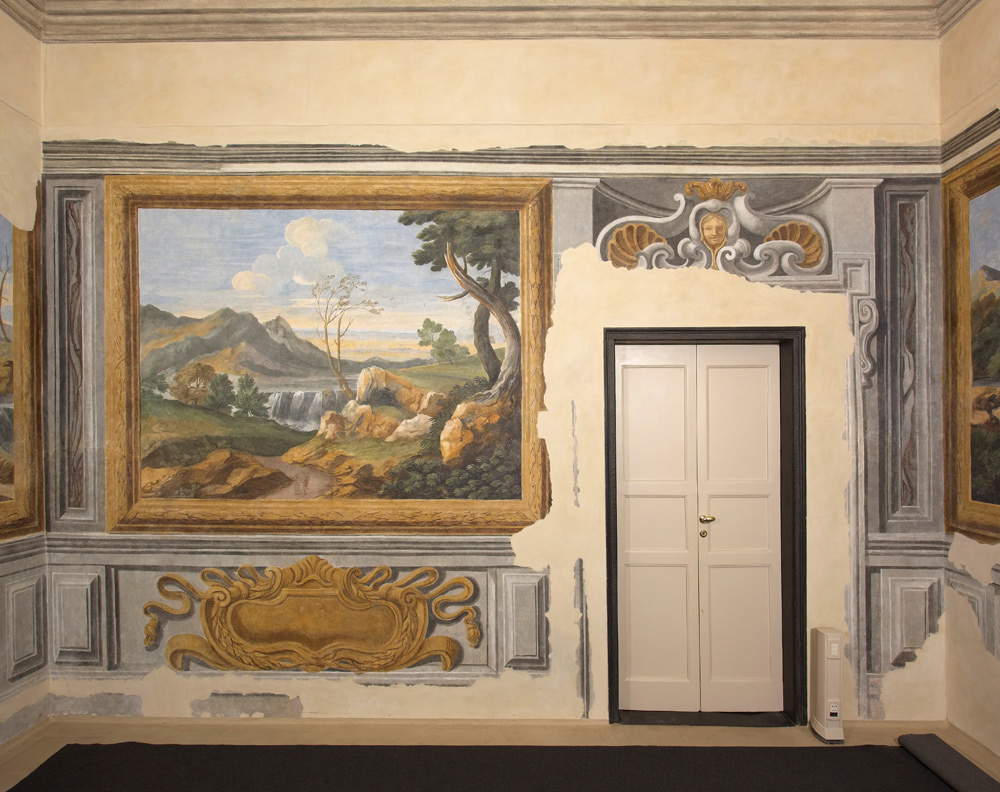 |
| Cavalier Tempesta’s drawing room |
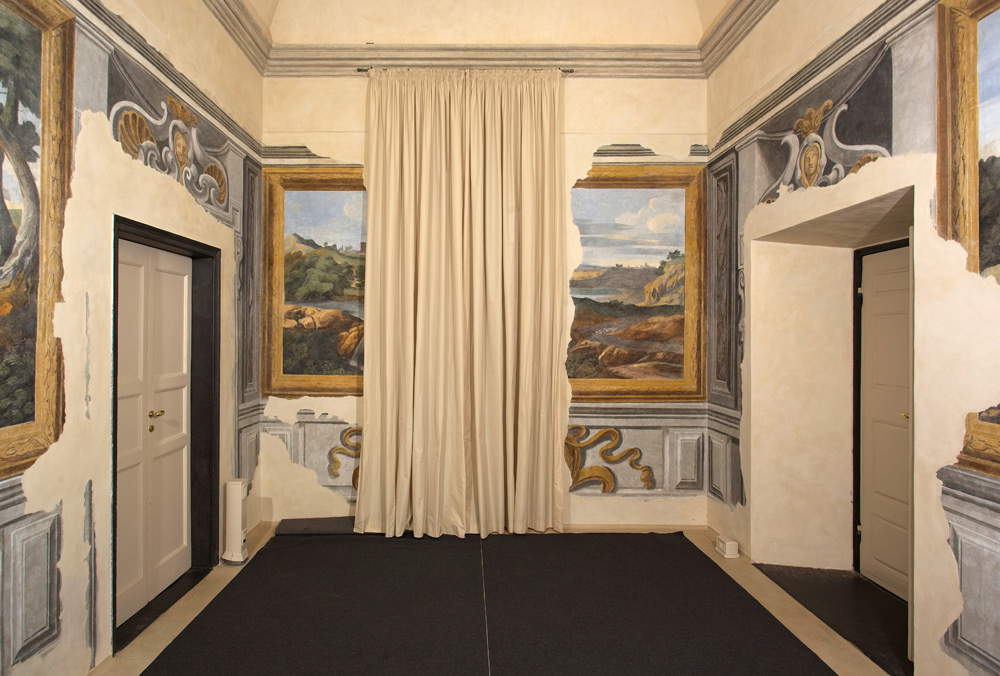 |
| Cavalier Tempesta’s drawing room |
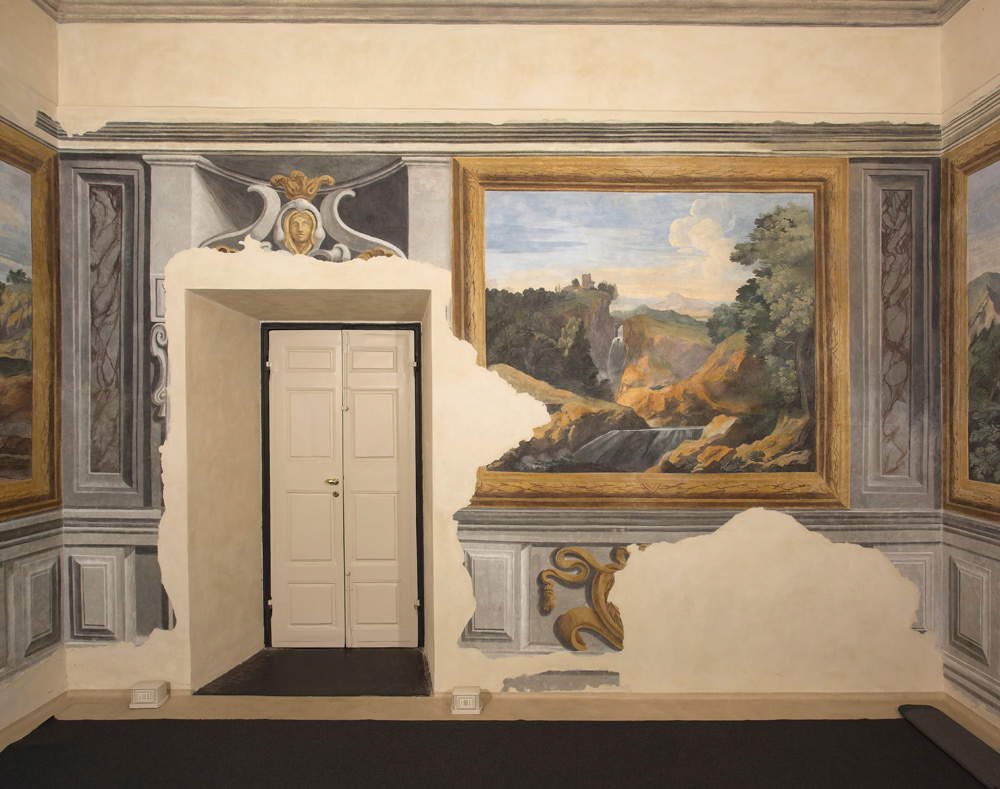 |
| Cavalier Tempesta’s drawing room |
In the presentation of the Cavalier Tempesta’s frescoes, the emphasis is on the fact that they are works that have been “rediscovered and restored”-the public sees the end result, however, but not what is behind the rediscovery and restoration. So what were the steps that precisely led to the rediscovery and restoration?
These frescoes were attributed a few years ago to Cavalier Tempesta by Mary Newcome based on the similarity to other frescoes that Cavalier Tempesta painted in Rome, in Palazzo Colonna. The restoration work was very long: I remember that there was also a manual work of scalpel removal in the cleaning of the pictorial surface of these frescoes, which, because of the dirt that covered them due to the passage of time, present some sections with a very unveiled surface, very light, which, however, also restores the elegance of the painting of this artist, who proceeded with thin veils even in the fresco production, therefore with a delicacy in the environmental restitution that is really unique. The sources speak, for both Mulier and Tavella, precisely of the attention in restoring the freshness of the waters, the airiness of the landscapes. Carlo Giuseppe Ratti, Tavella’s biographer, speaks of “sweet distances of the countries,” because both Mulier and Tavella used these mild colors and this transcending of hues to render the distances, the depths of landscapes that are certainly a repertoire, since they are invented landscapes, and yet each time they are ... always the same and always different, because they are those classical motifs that had been brought into vogue by Poussin in Rome, but which are constantly renewed.
How will the legacy left by these very important artists be captured in Genoa?
With a production that is all-encompassing and becomes so fashionable that so many aristocrats and collectors commission or buy canvases with this subject, so the painter’s skill was to vary the type of landscapes, of rocks, of backgrounds, of tree foliage in a repertoire of models that were continually modified to make these compositions more pleasing. Even, we know from sources that Tavella would later send landscape paintings to Vienna, Lisbon, and London, with a fortune that would go beyond the borders of the Republic of Genoa. So these are subjects that the painters then study in a production on paper of which the Strada Nuova Museums have a rich collection and which effectively returns this work of studying a repertoire of models that the painter had to keep ready at all times in order to later realize his landscapes on a large scale.
What is the importance of an event like this, which fits into the context of a particularly rich, intense and important cultural programming that Genoa has?
The Cavalier Tempesta room is really a unique event because we have no other Mulier frescoed rooms of this quality in Genoa. And by the way, Cavalier Tempesta’s is a name, a reference point for seventeenth-century Italian landscape painting. His nickname among other things comes from the fact that he was famous for creating scenes of storms and stormy seas, and this type of subject also became a type of great fortune. So Cavalier Tempesta is certainly a name of appeal, and the pairing with the Carlo Antonio Tavella room is in any case an in-depth study of a subject that becomes of fortune not only in Genoa but on a large scale, and it is also an enhancement of the collections of the Strada Nuova Museums, alongside Cavalier Tempesta’s frescoes in Palazzo Nicolosio Lomellino, and of collections that the public does not see frequently, such as the drawings which is of extraordinary importance. Genoa’s civic collections have about ten thousand drawings, which clearly for conservation reasons cannot be exposed to light permanently, but the occasions when there is a chance to show them to the public in a coordinated context with other exhibition venues are invaluable.
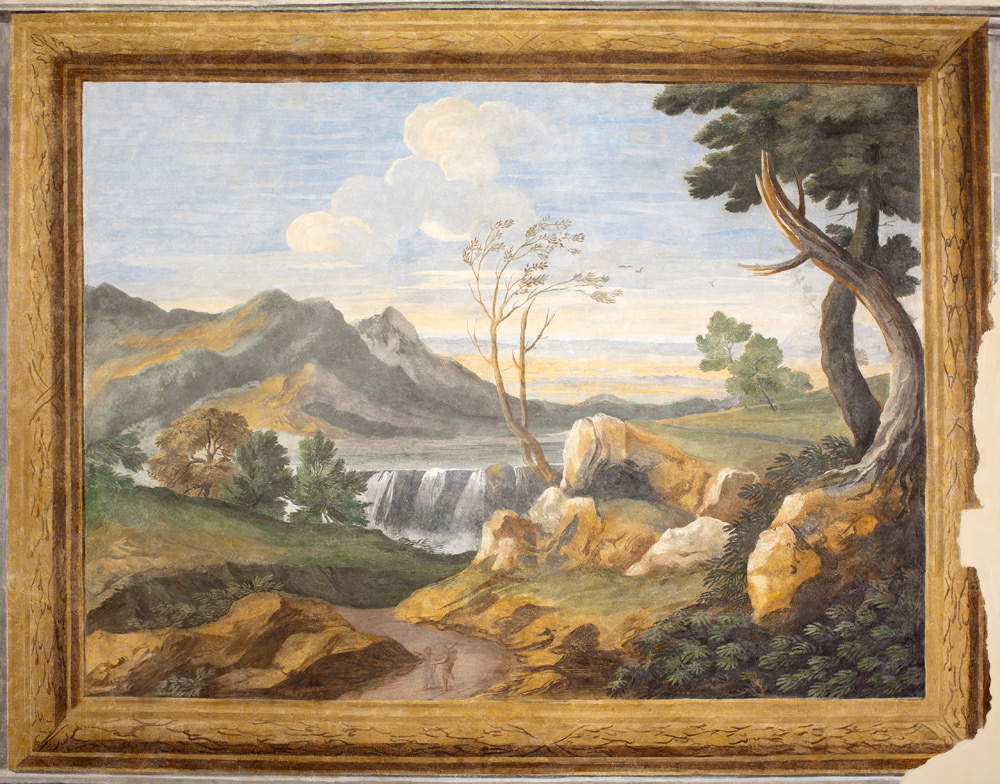 |
| Frescoes from Cavalier Tempesta’s drawing room |
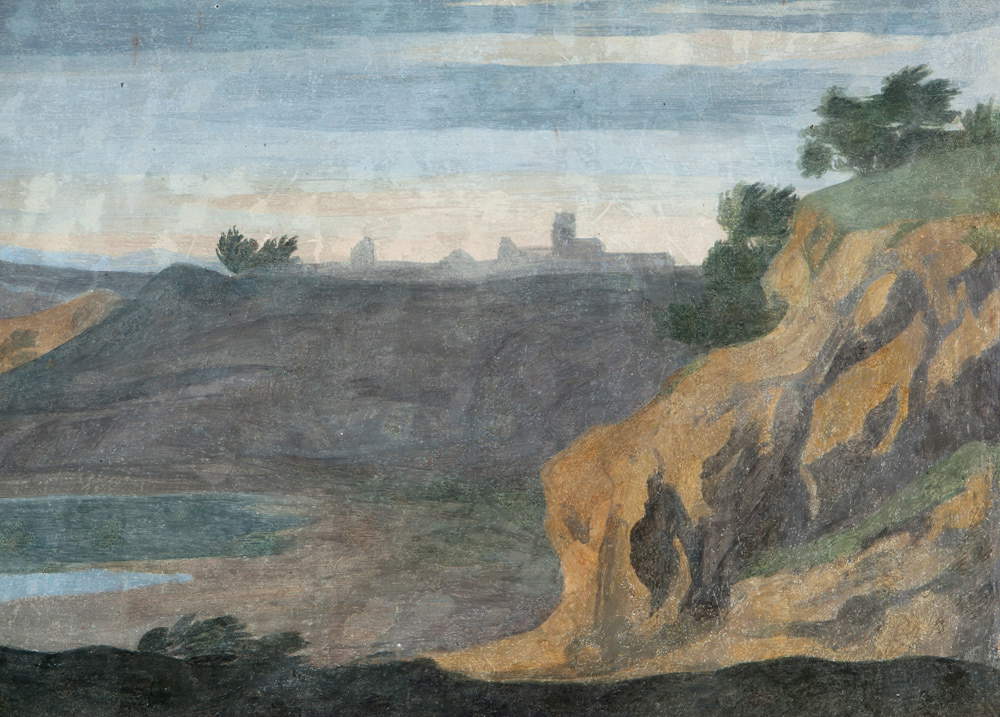 |
| Frescoes of Cavalier Tempesta’s drawing room |
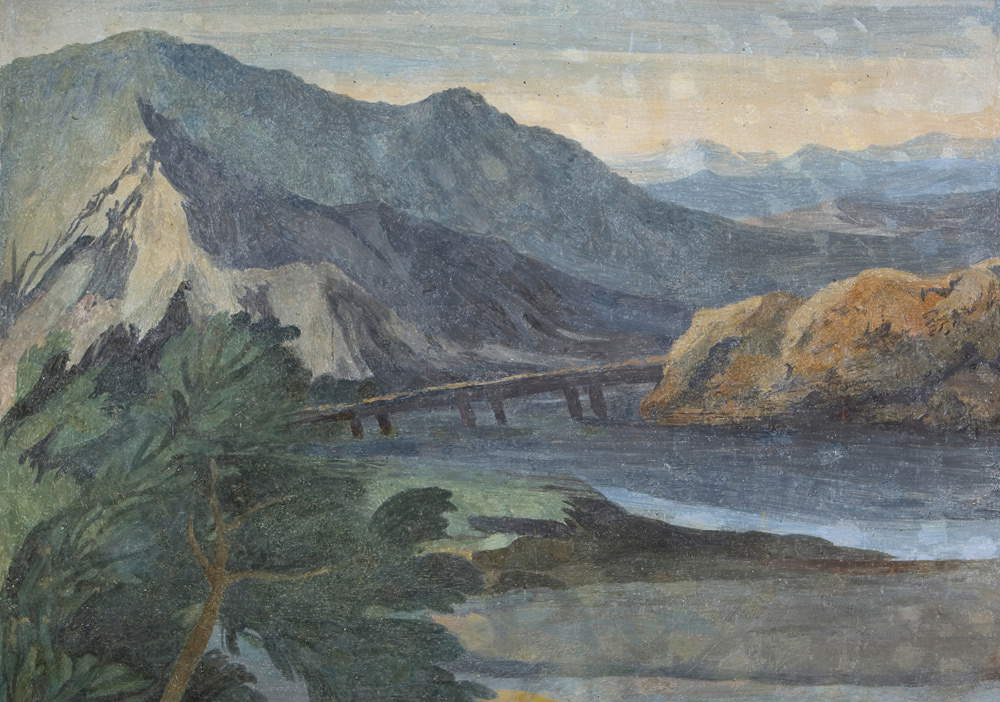 |
| Frescoes of Cavalier Tempesta’s drawing room |
The exhibition is, indeed, also made with drawings from the Strada Nuova Museums, and this allows us to introduce you also in another guise, because you hold the position of conservator of the Strada Nuova Museums’ collections and are in charge of the Drawings and Prints Cabinet. Every year the Strada Nuova Museums organize wonderful exhibitions of graphic art and drawings, but they require a major commitment: what are the main obstacles that such a commitment entails?
There are many obstacles, and they are often also economic, because it is necessary to restore the drawings before presenting them to the public, as well as to mount them, as is done in all the collections of the world, on non-acid cardboard passepartouts, suitable for conservation but also for public display, in a frame or in a showcase. Our sheets, because there are so many of them, are not all mounted on passepartouts, so it takes this preparation for every exhibition event. We at Palazzo Rosso have very beautiful spaces, set up by Franco Albini in the postwar restorations, with display cases that we have adapted for the exhibition of drawings. But it is necessary, each time, to find the funds to restore the drawings, to set them up and present them to the public, and to publish a catalog that enhances the exhibition project. Here, I would say these are the main obstacles.
What do you think are the characteristics that make a good and quality exhibition of drawings or of graphics in general?
A good exhibition of graphic art is one that has adequate scientific preparation work, and this is not only to make publications for insiders, but because it is only after the in-depth study of an artist (in the case of monographic exhibitions), or after the study of a genre or a school of draughtsmen, that one is able to make those juxtapositions and critical readings that are then also important for dissemination to the general public. Then it is clear that there are always two levels of reading: that for specialists, which then finds its way into the catalog, and that of the educational panels and the more popularized production, which, however, always has a considerable basis of study. We, having so many drawings, try over time to enhance the most important nuclei by making monographic exhibitions. Normally our exhibitions are dedicated to an artist and then we publish “Quaderni del Gabinetto dei Disegni e delle Stampe di Palazzo Rosso” that focus on a painter, and we also choose names that have an interest that transcends the Genoese or even the Italian one, and that are of interest to scholars even internationally. Clearly with the dispersion of graphic art collecting material we find, for example, drawings by Domenico Piola not only in Genoa but also in the Albertina in Vienna, the British Museum, the Louvre. Effectively our catalogs of graphic art have a very large circulation in museums around the world.
We conclude by asking if you can anticipate to our audience the projects you are working on that will materialize in the immediate future...
I am very happy to announce a project that I am working on with my colleagues, primarily Piero Boccardo, director of the Strada Nuova Museums, and others from the Cabinet of Drawings and Prints. It is an exhibition of prints by Albrecht Dürer: these are prints from a bequest promised by a private collector to the civic collections of graphic art, which we want to enhance as of now, even before the acquisition of this bequest, with an exhibition. They are prints of an exceptional quality, unique in the Italian panorama: I can say that they are wonderful works and they almost give back the first impression of the inked matrix on the paper, they almost look like drawings, because of the freshness of the blackness of the print and the liquidity of the stroke of the print, it is an excellent quality. Jonathan Bober, who is in charge of the graphic design cabinet at the National Gallery in Washington, will also be collaborating on the exhibition, and as an expert he stressed the very high level of these pieces that we will be exhibiting in the spring at Palazzo Rosso. We are still defining the date, but by the end of March or beginning of April we will exhibit these pieces, they are about sixty prints of both religious and secular subjects-a major exhibition project on which our efforts are now focused.
Warning: the translation into English of the original Italian article was created using automatic tools. We undertake to review all articles, but we do not guarantee the total absence of inaccuracies in the translation due to the program. You can find the original by clicking on the ITA button. If you find any mistake,please contact us.